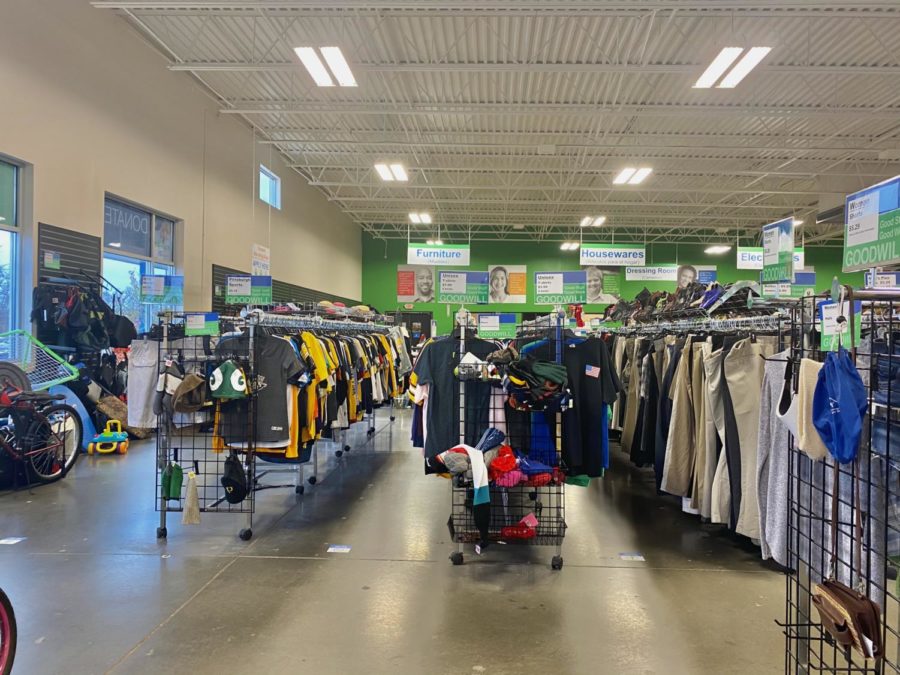The Positive Impacts of Thrifting
Thrifting is an environmentally-friendly and cost-effective way to shop.
Local thrift shops around PA accessible and cost efficient.
April 16, 2021
In the age of modern technology, online shopping has become increasingly popular especially during the pandemic. While online shopping is a quick and easy way to shop, it comes at a cost.
Clothing made over the last few years contains polyester which is a material that is not easily broken down. A single cotton T-shirt takes about 659 gallons of water to produce. With that amount of water being used for every single shirt made, we are threatening our own water supply.
An industry that helps reduce the use of toxic polyester fibers and water usage is thrifting. Thrifting helps reduce the overuse of water by supplying clothes that were once worn or passed down. It is not only good for the environment, but also for your wallet.
Thrifting is a cheap and sufficient way of life that has become more popular over the last few years. Although you may not find new items or items perfectly intact, you are reducing the amount of waste high-end clothing companies produce. Large corporations price their products higher due to the number of resources needed to manufacture. Thrift stores, in comparison, have low prices due to second-hand usage which makes it more affordable.
There is no shame in those who online shop or buy from stores, but there is a lot to consider if you do. Thrift stores are located all over Pennsylvania, making it accessible and obtainable to make the switch.
Many stores such as Goodwill take donations from the community to help support their business. When they receive donations after a certain amount of time, they send their clothes to textile recycling centers. Their clothes are constantly being recycled and reused by people all over the world. This is just one of the many examples of how thrifting clothes are more environmentally friendly long-term.
Personally, I find thrifting to be interesting, as you are more likely to find unique pieces both clothing and otherwise. A majority of large clothing companies do not take the environment into consideration, especially when you buy online. Your packages are shipped with nonrecyclable materials on top of the clothing that took large resources to make.
The fashion industry produces 10% of carbon emission as well as being the second-largest consumer of our water supply. Fashion industries around the world are known for paying their employees little to nothing, especially in foreign countries.
Popular companies such as H&M, Forever 21, Zara, Nike, and so on practice child labor within their companies. Child labor is a topic not commonly discussed, and most turn a blind eye when discussing young children making their clothes. It is an uncomfortable topic to discuss, but it is still incredibly real and prevalent within the fashion industry. A majority of these children are working for less than the minimum wage in poor conditions to support their families. Looking at brands such as Nike and how much profit they make off of their merchandise, it is difficult to understand why they still use children as a part of their manufacturing.
While thrifting is beneficial to those who want to make a positive impact environmentally and financially, it extends wider than just clothes. Those who are of low-income families that are in need of basic necessities are able to access items at thrift shops. Items such as plates, silverware, children’s books, and learning materials can all be found at common thrift stores.
As we approach summer, we must make an effort to try to be more environmentally friendly. Some have started using metal straws and reusable bags, but shopping in a more sustainable way is something that could be practiced more.
Our generation is heavily involved in activism, and while many practice what they preach, it often seems as though others choose to avoid the topic. The number of chemicals, water usage, materials, and unethical labor put into clothing companies should be enough to have you rethink your purchases.
There are, however, some companies that are environmentally friendly and do their best to reduce their use of plastic materials. While not every company can be considerate, I urge people to look into companies before they purchase items. Even the smallest of changes can have a positive long-term effect, especially on our environment.
Thrifting locally or through online stores is a way to support smaller companies while putting your money into an ethical cause. Donating to local thrift stores helps keep businesses running and it is free to do so. When donating to places such as Goodwill, you are able to get a tax write-off on things you donate.
While thrifting became relatively popular over the years as a trend, it has an immense amount of positives that go into it. Thrifting doesn’t mean that you have to get rid of your favorite shopping companies, but instead, gives you a more friendly option for the future.













